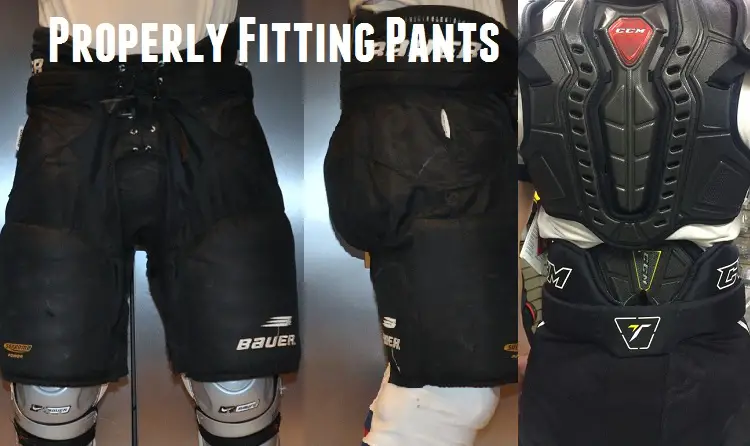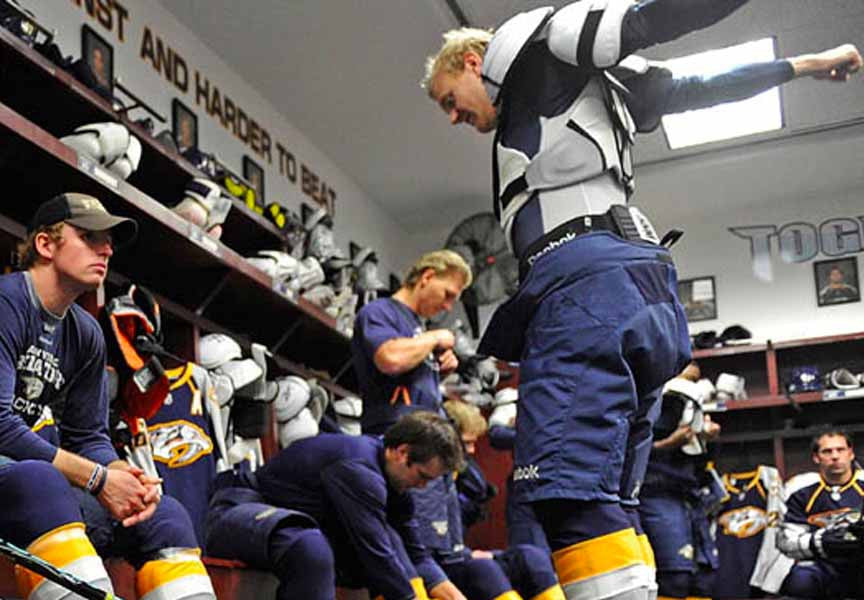How should Hockey pants fit? Snugly around the waist and extend to the top of the knee. They should allow a full range of motion without sliding or shifting.
Properly fitting hockey pants are essential for players’ safety and performance. They protect the hips, thighs, and tailbone from impacts and falls. A snug fit ensures the padding stays in place during play, providing consistent protection. Players should feel comfortable and unrestricted, allowing them to skate, shoot, and manoeuvre effectively.
The pants should overlap with the hockey girdle and shin guards for seamless protection. It is crucial to try on different brands and models to find the best fit. If needed, suspenders or a belt can help keep the pants in place.
Credit: discounthockey.com
The Importance Of Proper Fit In Hockey Pants
Hockey pants are essential for every player. They protect the hips, thighs, and tailbone. A proper fit ensures both safety and comfort. Ill-fitting pants can impede movement and increase injury risk.
Impact On Performance
Well-fitted hockey pants enhance performance. They allow for fluid movement and quick turns, allowing players to skate faster and with better agility. Loose pants may cause tripping or slow movements, while tight pants restrict leg movement, affecting speed and power.
Reducing Injury Risks
Properly fitted hockey pants reduce injury risks. They offer better protection to vital areas. Pants that fit well stay in place during play. This stability ensures pads cover the intended areas. Poorly fitting pants can shift and leave regions exposed.
A good fit also helps absorb impacts. The padding remains in the correct position, safeguarding the player, which is crucial in a high-contact sport like hockey.
| Fit Aspect | Impact |
| Waist | It should be snug but not tight. |
| Length | It should cover the thighs adequately. |
| Padding | Should align with hips, thighs, and tailbone. |
Please make sure the pants are neither too loose nor too tight. This balance maintains comfort and safety; a proper fit is crucial for every hockey player.
Anatomy Of Hockey Pants
Hockey pants are vital for player safety and comfort. They protect the hips, thighs, and lower back. Understanding their anatomy helps in selecting the right fit.
Key Features To Look For
Hockey pants have several critical features. These features ensure both protection and mobility.
- Padding: Essential for shock absorption and injury prevention.
- Adjustable Waist: Allows for a snug fit and comfort.
- Thigh Guards: Protect the thigh area from impacts.
- Spine Protection: Shields the lower back from hits.
- Ventilation: Keeps players cool and dry during the game.
Material And Durability
The material of hockey pants affects their durability and comfort. Strong materials last longer and provide better protection.
| Material | Durability | Comfort |
| High-Density Foam | High | Moderate |
| Polyester | Moderate | High |
| Nylon | High | Moderate |
Could you write down this final measurement?
Choose materials that balance durability and comfort. Strong materials ensure long-lasting protection.
Measuring Yourself For Hockey Pants
Ensuring your hockey pants fit correctly is crucial for comfort and protection. A good fit helps you move freely on the ice. This guide will help you measure yourself accurately.
Tools You’ll Need
- Measuring tape
- Pen and paper
- Helper (optional but recommended)
Step-by-step Guide
- Waist Measurement: Wrap the measuring tape around your waist. The tape should sit comfortably where your belt usually goes. Could you write down the measurement?
- Hip Measurement: Stand with your feet together. Wrap the tape around the widest part of your hips. Keep the tape level. Note this number.
- Thigh Measurement: Measure the circumference of the widest part of your thigh. This ensures the pants will fit comfortably. Could you record this measurement?
- Inseam Measurement: Measure from the top of your inner thigh to your ankle. This helps determine the length of the pants. Could you write down this final measurement?
Use these measurements to find your ideal hockey pants size. Check the manufacturer’s chart for the best fit. Well-fitted pants offer better protection and comfort on the ice.
Credit: www.youtube.com
Fit Criteria: Beyond The Size Chart
Finding hockey pants that fit goes beyond picking a size from a chart. Proper fit ensures safety and performance on the ice. This section will explore the critical criteria for fitting hockey pants.
Waist Fit And Adjustability
The waist fit is crucial for comfort and movement. Hockey pants should sit comfortably on your hips and not slide down during play. Most pants come with adjustable features.
- Belt or lace systems: These help tighten the pants around your waist.
- Velcro straps: Provide easy adjustments for a snug fit.
Check that the waist is neither too tight nor too loose. You should be able to move freely without discomfort.
Length And Coverage
The proper length ensures maximum protection. Hockey pants should cover your thighs and tailbone and end just above your knee pads.
The pants should not restrict your skating stride. When you bend your knees, the pants should stay in place. Ensure they cover your lower back when you lean forward.
Use this table as a quick reference for length and coverage:
| Body Part | Coverage |
| Thighs | Fully covered |
| Tailbone | Fully protected |
| Lower Back | Covered when leaning |
Check the length by wearing your entire gear. Ensure everything stays in place during movement.
Trying On Hockey Pants: What To Look For
Trying on hockey pants can be tricky. You want to make sure they fit well, which helps with comfort and protection. Here is what to look for when trying on hockey pants.
Comfort And Mobility
Comfort is key. The pants should not pinch or rub. They must allow you to move freely. You should be able to skate, bend, and squat easily. Make sure to try different moves in the pants. This helps to check if they are comfortable.
Protection And Padding Placement
Protection is critical. The padding should cover your hips, thighs, and tailbone. Make sure the padding stays in place when you move. Check that the padding is thick and firm. This will help to absorb impacts during the game.
| Feature | Importance |
| Comfort | High |
| Mobility | High |
| Padding Placement | Very High |
| Protection | Very High |
- Check for a snug fit around the waist.
- Ensure the pants do not slide down.
- Look for adjustable straps or belts.
- Try on pants with your full gear for a better-fit check.
Remember, well-fitting hockey pants can enhance your game. They provide comfort and essential protection.
Adjustments And Customizations
Properly fitting hockey pants are crucial for comfort and protection. Knowing how to adjust and customize them ensures the best fit. This section will guide you through fine-tuning and tailoring your hockey pants.
Fine-tuning The Fit
Fine-tuning your hockey pants ensures maximum mobility and protection. Here are some tips:
- Waist Adjustments: Check the Velcro straps or belts. Tighten or loosen as needed.
- Length Adjustments: Ensure the pants cover the upper leg but don’t allow for tight movement.
- Padding Position: Adjust the padding to cover hips and thighs adequately.
If the pants feel too loose or too tight, make minor adjustments. Always wear your full gear during adjustments.
When To Consider Tailoring
Sometimes, standard adjustments aren’t enough. Tailoring might be the solution:
- Custom Fit: A tailor can adjust the waist and length to your measurements.
- Padding Modifications: A professional can add or remove padding for better protection.
- Repair and Reinforcement: Tailors can fix tears or reinforce weak areas.
If your pants still aren’t right, consider professional tailoring. A tailor can provide a perfect fit, enhancing comfort and safety.
Common Fitting Mistakes To Avoid
Getting the right fit for hockey pants is crucial. Mistakes can lead to discomfort or even injuries. Below are some common fitting mistakes you should avoid.
Choosing Style Over Function
Many players pick pants based on style. This is a mistake. Always prioritize function over looks. Stylish pants might not offer the best protection.
Ensure the pants cover your hips and thighs. They should also allow for unrestricted movement. Stylish pants often lack these features. Opt for pants that provide maximum safety and comfort.
Ignoring Brand Size Differences
Different brands have different sizing standards. Never assume all brands fit the same. Always check the sizing chart for the brand you choose.
Measure your waist and hips before buying. Compare these measurements to the brand chart. This will help you select the best fit for you.
| Brand | Size | Waist (inches) | Hips (inches) |
| Brand A | Medium | 30-32 | 36-38 |
| Brand B | Medium | 32-34 | 38-40 |
This table shows how sizes can differ. Always check before you buy. This ensures you avoid common fitting mistakes.
Credit: www.youtube.com
Care And Maintenance For Longevity
Proper care and maintenance of hockey pants ensure they last longer. Regular cleaning and correct storage are vital. Follow these tips to keep your gear in top condition.
Routine Cleaning Tips
Cleaning hockey pants regularly prevents odor and bacteria buildup. Follow these steps:
- Check the label: Always read the manufacturer’s instructions.
- Remove pads: Take out removable pads before washing.
- Hand wash: Use mild detergent and cold water.
- Rinse thoroughly: Ensure all soap is removed to avoid skin irritation.
- Air dry: Hang the pants to dry in a well-ventilated area.
Never use a dryer, as heat can damage the materials.
Storage Solutions
Proper storage of hockey pants prolongs their life. Follow these storage tips:
- Dry thoroughly: Ensure pants are completely dry before storing.
- Use a gear bag: Store pants in a ventilated gear bag to prevent moisture buildup.
- Avoid damp areas: Store pants in a cool, dry place.
- Keep away from sunlight: Prolonged exposure can fade colors and weaken materials.
Proper storage prevents mold and unpleasant odors.
Frequently Asked Questions
How Should Hockey Pants Fit?
Hockey pants should fit snugly around the waist and hips, allowing easy movement. They should also completely cover the kidney and thigh areas, ensuring they don’t restrict skating or bending.
What Size Hockey Pants Do I Need?
To find the right size, measure your waist and hips. Refer to the manufacturer’s chart. Try them on with your gear to ensure a good fit.
How To Adjust Hockey Pants?
Most hockey pants have adjustable straps or belts. Tighten or loosen them for a comfortable fit. Ensure they stay in place during the play.
Should Hockey Pants Cover Shin Pads?
Yes, hockey pants should overlap with shin pads. This ensures complete protection. The pants should cover the top of the shin pads.
Conclusion
Achieving the perfect fit for hockey pants is crucial. Properly fitting pants enhance performance and provide essential protection. Ensure a snug fit around the waist and ample coverage for the thighs. Remember to consider mobility and comfort when choosing. With these tips, you’ll be ready to hit the ice safely.







